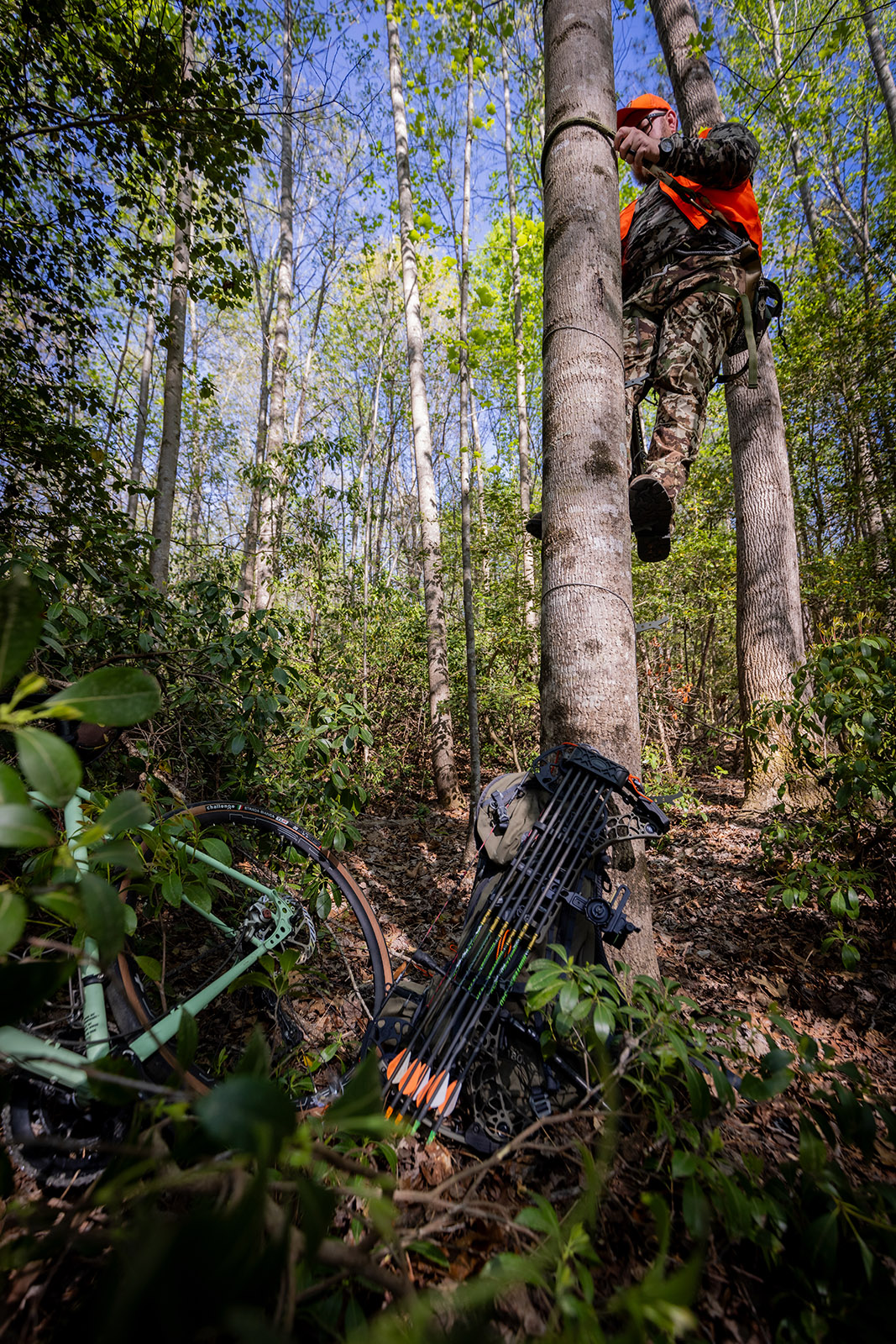By James Moffitt
Photos by Meghan Marchetti/DWR
As my hunting style has evolved, I’ve looked for ways to differentiate and improve my approach. In my early hunting career, I was lucky to gain access to a couple of leases that required no more than a couple hundred-yard walk into great stands. But with different properties available, eventually I faced the need to set up a stand anywhere and, recently, the need to get much further back into the properties I now hunt.
While hiking into a hunting spot is a great way to observe your surroundings, scout, and explore the outdoors, I’ve found that riding a bike has several advantages for me. As a former competitive cyclist, riding bikes in the woods is nothing new and it was fairly easy to add hunting by bike into my repertoire.

Using a bike to scout and access hunting spots is a great alternative for public lands, but make sure it’s allowed on that property first.
Hunting by bike has also become incredibly popular with hunting influencers and on hunting media channels. With manufacturers making awesome dedicated hunting bikes, it’s easier than ever to ride into the woods and gain access to more remote hunting locations.
For me, hunting by bike has offered several advantages:
- Better access – hunting by bike has allowed me to travel much deeper into my hunting spots even for short sits. While it might take me 15 minutes to hike a mile in, I can get three miles in with a bike in the same amount of time.
- Saving effort – Hiking’s tough, especially with a pack, weapon, climbing sticks, and more. Using a bike capitalizes on my energy and gives me more energy for the hunt. It’s also a bit easier on aging joints!
- Covering scent – Unlike tracking in scent while walking, rubber tires and quieter access by bike feels like it helps me spook less game than hiking in.

Biking in can help you access hunting spots off the beaten path.
While this article includes some tips for hunting by bike, it’s important to note that it’s not allowed everywhere. Certain Wildlife Management Areas (WMAs) and states have different regulations when it comes to hunting by bike and it’s important to be aware of them before taking to the woods.
Bike Handling
For the sake of safety, you should be confident in your bike-handling abilities while riding in low light, over varied terrain, and loaded with gear. Always wear a helmet when you’re in motion.
To practice bike handling, you should load up with your gear and go for a ride. Start with flat ground or paved trails. As you build your confidence, you could try riding towpaths, mountain bike skills courses, or at your hunting spots. Being able to navigate a bike through mud and over or around rocks and roots will be crucial to getting into the places you want to hunt.

Getting comfortable with your gear and the bike is important, and the summer months are a great time to do this.
For this reason, as well, many hunters choose “fat bikes” or mountain-style bikes. The larger tires and frame clearance for rocks and debris will also improve your handling abilities. If you’re on the market and shopping, I also recommend looking at bikes that come with either mechanical or hydraulic disc brakes. They offer the best in speed control and stopping.
Secure Your Gear
Modern bikes have an amazing array of modularity, allowing you to set the bike up in a way that best suits your riding and hunting style. Whether you use racks mounted to the frame, a cart pulled behind the bike, or choose to have everything on your back, having your gear properly stored will make for a better ride…and keep your headlamp from bouncing off down the trail.
In most cases, you can work with your local bike shop to explore options that would work for your setup. Most hunting bike companies also offer a selection of racks and even things like bow and rifle mounts. Regardless of how you choose to set your bike up, I recommend using additional straps to secure gear.
Taking a couple of extra seconds to add a securing strap will keep your gear in place, which in turn will help your bike handling. The last thing you want is to go into a sharp turn and have a heavy piece of your gear shift and pull you off balance.
Consider Your Hide
Because I’m using a bike that I also use for training and riding, I’ve opted for carrying camo netting that I place over the bike while I’m in the tree to hide it. Depending on what kind of bike you get (most hunting bikes come in camo), you may need to make considerations about how to stash the bike while you’re hunting. Cheap camo netting, a blind, or a natural cover all work great.

You can use natural cover to hide your bike, or bring supplies.
Riding into your hunt is a great way to explore the back corners of your local WMA or push the boundaries of your lease. It’s also an awesome way to save time by getting to your stand fast. If you’re considering adding a bike to your hunting arsenal, start now—figure out your setup and gear needs and practice this off-season so that you’re ready to go this fall.


